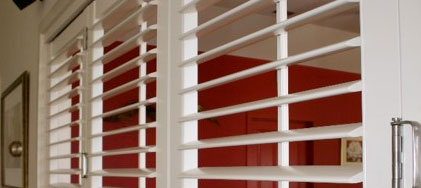HOW TO GET THE BEST OUT OF YOUR SHUTTERS & LOUVRES
Louvres and shutters are one of the best ways to add long-lasting value to your home, whilst surviving extreme weather and traversing the changing trends. Here we explain how the different types function, and how they are constructed.
Decorative Function
Often shutters are for decorative purposes only, such as a small vent on a gable end. A stained timber shutter can make an otherwise plain cable end, into a feature with a Mediterranean look.
With these, it is recommended that the shutter is a stand-alone item that is fixed to the outside of a building this is opposed to having an opening which then needs to be framed and sealed off with flashings etc. An opening will also let heat out of the attic cavity, causing a home to lose heat, and let unwanted creepy crawlies in. If you were to choose a decorative shutter, they can normally be glued in place, eliminating the need for fixings through the cladding.
Download The Complete Guide to Shutters & Louvres [Free E-Book]
Open/Closed Function
There are different uses for shutters and different shutter types to suit the application.
 The thinnest and lightest shutters are the ones used for decoration. These normally have 28mm wide closed blades and a frame at 19mm thick.
The thinnest and lightest shutters are the ones used for decoration. These normally have 28mm wide closed blades and a frame at 19mm thick.
This blade is the most economical to make and will last longer than a 28mm open blade, especially when exposed to weather. The closed blade design makes the shutter look like it is made up of individual blades.

If a shutter is used for exterior ventilation, normally a larger 42 x 10mm blade is used.
This is more resistant to splitting and warping than the 25mm blades. The frame is normally thicker (35mm) for extra stability.


Louvre doors have a 25mm blade. They are excellent for internal use and extremely common in places like laundry’s, kitchens and bedroom closets.
These can be either closed, like the decorative shutter, or open. They normally have a middle horizontal rail for extra stability, and sometimes have a solid panel in the bottom, instead of louvre blades.
Most locally, custom-made louvres are 36mm thick, but often imported louvres are about 19mm thick.
Adjustable Function

Interior adjustable shutters are manufactured differently as opposed to exterior shutters.
The shutters are often fitted together using plastic pins which are fastened into the frames of the louvres. These pins fit neatly into the timber and are perfect for interior. These louvres are not sustainable for exterior use due to weather exposure. This type of shutter normally has a larger bulky blade 70mm or 90mm wide and 12mm thick.
Some manufacturers offer ‘aerofoil’ blades shaped like a plane wing. This often helps with closing the shutter more tightly as the shape of the blade helps diminish the gap between the blades.
Achieve a more modern look with the flat blade and rounded edges.
For exterior adjustable shutters, we recommend using a metal fixing and adjusting system. Unlike timber, stainless steel or aluminium can be manufactured in small mechanisms that will handle the effects of weather. An exterior timber shutter can create a wonderful look for your home ensuring the adjusting mechanisms are stainless or aluminium for a lasting product.



